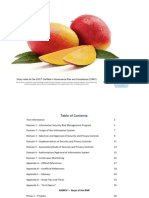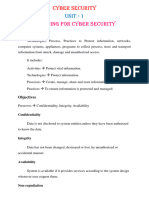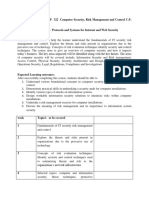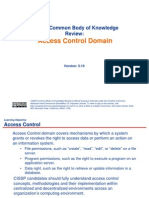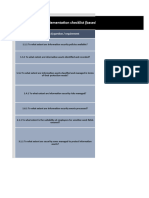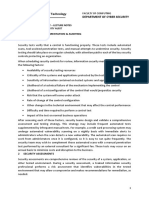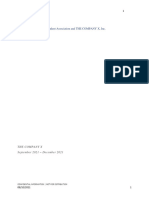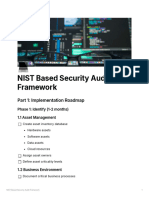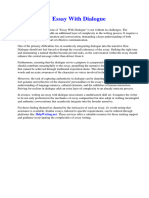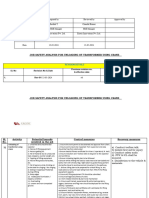CAP Exam Outline
CAP Exam Outline
Uploaded by
ironmanCopyright:
Available Formats
CAP Exam Outline
CAP Exam Outline
Uploaded by
ironmanCopyright
Available Formats
Share this document
Did you find this document useful?
Is this content inappropriate?
Copyright:
Available Formats
CAP Exam Outline
CAP Exam Outline
Uploaded by
ironmanCopyright:
Available Formats
Certification Exam Outline
Effective Date: August 15, 2021
About CAP
The Certified Authorization Professional (CAP®) is an information security practitioner who advocates for
security risk management in pursuit of information system authorization to support an organization’s
mission and operations in accordance with legal and regulatory requirements.
The broad spectrum of topics included in the CAP Common Body of Knowledge (CBK®) ensure its relevancy
across all disciplines in the field of information security. Successful candidates are competent in the following
seven domains:
• Information Security Risk Management Program
• Scope of the Information System
• Selection and Approval of Security and Privacy Controls
• Implementation of Security and Privacy Controls
• Assessment/Audit of Security and Privacy Controls
• Authorization/Approval of Information System
• Continuous Monitoring
Experience Requirements
Candidates must have a minimum of two years cumulative work experience in one or more of the seven
domains of the CAP CBK.
A candidate that doesn’t have the required experience to become a CAP may become an Associate of (ISC)²
by successfully passing the CAP examination. The Associate of (ISC)² will then have three years to earn the
two year required experience. You can learn more about CAP experience requirements and how to account
for part-time work and internships at www.isc2.org/Certifications/CAP/experience-requirements.
Accreditation
CAP is in compliance with the stringent requirements of ANSI/ISO/IEC Standard 17024.
Job Task Analysis (JTA)
(ISC)² has an obligation to its membership to maintain the relevancy of the CAP. Conducted at regular
intervals, the Job Task Analysis (JTA) is a methodical and critical process of determining the tasks that are
performed by security professionals who are engaged in the profession defined by the CAP. The results of the
JTA are used to update the examination. This process ensures that candidates are tested on the topic areas
relevant to the roles and responsibilities of today’s practicing information security professionals.
CAP Certification Exam Outline 2
CAP Examination Information
Length of exam 3 hours
Number of items 125
Item format Multiple choice
Passing grade 700 out of 1000 points
Exam availability English
Testing center Pearson VUE Testing Center
CAP Examination Weights
Domains Weight
1. Information Security Risk Management Program 16%
2. Scope of the Information System 11%
3. Selection and Approval of Security and Privacy Controls 15%
4. Implementation of Security and Privacy Controls 16%
5. Assessment/Audit of Security and Privacy Controls 16%
6. Authorization/Approval of Information System 10%
7. Continuous Monitoring 16%
Total: 100%
CAP Certification Exam Outline 3
Domain 1:
Information Security Risk
Management Program
1.1 Understand the foundation of an organization information security risk
management program
» Principles of information security
» Risk management frameworks (e.g., National Institute of Standards and Technology (NIST), cyber security
framework, Control Objectives for Information and Related Technology (COBIT), International Organization
for Standardization (ISO) 27001, International Organization for Standardization (ISO) 31000)
» System Development Life Cycle (SDLC)
» Information system boundary requirements
» Security controls and practices
» Roles and responsibilities in the authorization/approval process
1.2 Understand risk management program processes
» Select program management controls
» Privacy requirements
» Determine third-party hosted information systems
1.3 Understand regulatory and legal requirements
» Familiarize with governmental, organizational and international regulatory security and privacy requirements
(e.g., International Organization for Standardization (ISO) 27001, Federal Information Security Modernization
Act (FISMA), Federal Risk and Authorization Management Program (FedRAMP), General Data Protection
Regulation (GDPR), Health Insurance Portability and Accountability Act (HIPAA))
» Familiarize with other applicable security-related mandates
CAP Certification Exam Outline 4
Domain 2:
Scope of the Information System
2.1 Define the information system
» Determine the scope of the information system
» Describe the architecture (e.g., data flow, internal and external interconnections)
» Describe information system purpose and functionality
2.2 Determine categorization of the information system
» Identify the information types processed, stored or transmitted by the information system
» Determine the impact level on confidentiality, integrity, and availability for each information type
(e.g., Federal Information Processing Standards (FIPS) 199, International Organization for Standardization/
International Electrotechnical Commission (ISO/IEC) 27002, data protection impact assessment)
» Determine information system categorization and document results
CAP Certification Exam Outline 5
Domain 3:
Selection and Approval of Security
and Privacy Controls
3.1 Identify and document baseline and inherited controls
3.2 Select and tailor controls to the system
» Determine applicability of recommended baseline and inherited controls
» Determine appropriate use of control enhancements (e.g., security practices, overlays, countermeasures)
» Document control applicability
3.3 Develop continuous control monitoring strategy
(e.g., implementation, timeline, effectiveness)
3.4 Review and approve security plan/Information Security Management System (ISMS)
CAP Certification Exam Outline 6
Domain 4:
Implementation of Security and
Privacy Controls
4.1 Implement selected controls
» Determine mandatory configuration settings and verify implementation in accordance with current industry
standards (e.g., Information Technology Security Guidance ITSG-33 – Annex 3A, Technical Guideline for
Minimum Security Measures, United States Government Configuration Baseline (USGCB), National Institute
of Standards and Technology (NIST) checklists, Security Technical Implementation Guides (STIGs), Center for
Internet Security (CIS) benchmarks, General Data Protection Regulation (GDPR))
» Ensure that implementation of controls is consistent with the organizational architecture and associated
security and privacy architecture
» Coordinate implementation of inherited controls with control providers
» Determine and implement compensating/alternate security controls
4.2 Document control implementation
» Document inputs to the planned controls, their expected behavior, and expected outputs or deviations
» Verify the documented details of the controls meet the purpose, scope and risk profile of the information
system
» Obtain and document implementation details from appropriate organization entities
(e.g., physical security, personnel security, privacy)
CAP Certification Exam Outline 7
Domain 5:
Assessment/Audit of Security and
Privacy Controls
5.1 Prepare for assessment/audit
» Determine assessor/auditor requirements
» Establish objectives and scope
» Determine methods and level of effort
» Determine necessary resources and logistics
» Collect and review artifacts (e.g., previous assessments/audits, system documentation, policies)
» Finalize the assessment/audit plan
5.2 Conduct assessment/audit
» Collect and document assessment/audit evidence
» Assess/audit implementation and validate compliance using approved assessment methods
(e.g., interview, test and examine)
5.3 Prepare the initial assessment/audit report
» Analyze assessment/audit results and identify vulnerabilities
» Propose remediation actions
5.4 Review initial assessment/audit report and perform remediation actions
» Determine risk responses
» Apply remediations
» Reassess and validate the remediated controls
5.5 Develop final assessment/audit report
5.6 Develop remediation plan
» Analyze identified residual vulnerabilities or deficiencies
» Prioritize responses based on risk level
» Identify resources (e.g. financial, personnel, and technical) and determine the appropriate timeframe/
schedule required to remediate deficiencies
CAP Certification Exam Outline 8
Domain 6:
Authorization/Approval of
Information System
6.1 Compile security and privacy authorization/approval documents
» Compile required security and privacy documentation to support authorization/approval decision by the
designated official
6.2 Determine information system risk
» Evaluate information system risk
» Determine risk treatment options (i.e., accept, avoid, transfer, mitigate, share)
» Determine residual risk
6.3 Authorize/approve information system
» Determine terms of authorization/approval
CAP Certification Exam Outline 9
Domain 7:
Continuous Monitoring
7.1 Determine impact of changes to information system and environment
» Identify potential threat and impact to operation of information system and environment
» Analyze risk due to proposed changes accounting for organizational risk tolerance
» Approve and document proposed changes (e.g., Change Control Board (CCB), technical review board)
» Implement proposed changes
» Validate changes have been correctly implemented
» Ensure change management tasks are performed
7.2 Perform ongoing assessments/audits based on organizational requirements
» Monitor network, physical and personnel activities (e.g., unauthorized assets, personnel and related activities)
» Ensure vulnerability scanning activities are performed
» Review automated logs and alerts for anomalies (e.g., security orchestration, automation and response)
7.3 Review supply chain risk analysis monitoring activities (e.g., cyber threat reports, agency
reports, news reports)
7.4 Actively participate in response planning and communication of a cyber event
» Ensure response activities are coordinated with internal and external stakeholders
» Update documentation, strategies and tactics incorporating lessons learned
7.5 Revise monitoring strategies based on changes to industry developments introduced through
legal, regulatory, supplier, security and privacy updates
7.6 Keep designated officials updated about the risk posture for continuous authorization/approval
» Determine ongoing information system risk
» Update risk register, risk treatment and remediation plan
7.7 Decommission information system
» Determine information system decommissioning requirements
» Communicate decommissioning of information system
» Remove information system from operations
CAP Certification Exam Outline 10
You might also like
- 8 - IMG Friendly HospitalsDocument5 pages8 - IMG Friendly Hospitalsarfaarooj666100% (1)
- IT Audit Fundamentals Course ContentDocument45 pagesIT Audit Fundamentals Course Contentasebe100% (1)
- Certified in Cybersecurity Exam Outline Aug22Document8 pagesCertified in Cybersecurity Exam Outline Aug22R Nil67% (3)
- CGRC Exam OutlineDocument11 pagesCGRC Exam OutlineAtinuke OweteNo ratings yet
- NIST SP800-115 - Technical Guide To Information Security Testing and AssessmentDocument9 pagesNIST SP800-115 - Technical Guide To Information Security Testing and AssessmentDodi IrawanNo ratings yet
- CAP Exam OutlineDocument12 pagesCAP Exam OutlineHyder BasetNo ratings yet
- CGRC Exam Outline November 2023 EnglishDocument11 pagesCGRC Exam Outline November 2023 Englishedson atuhaireNo ratings yet
- SSCP Exam Outline Sept17Document13 pagesSSCP Exam Outline Sept17halakahiki82No ratings yet
- SSCP Exam OutlineDocument11 pagesSSCP Exam Outlineironman100% (1)
- CGRC Course BrouchurDocument18 pagesCGRC Course Brouchurvikas20mehraNo ratings yet
- The Mango Guide Ver2Document41 pagesThe Mango Guide Ver2iotcsiotNo ratings yet
- CISSP ISSMP Exam Outline November 2022 EnglishDocument11 pagesCISSP ISSMP Exam Outline November 2022 EnglishDimitris KolettisNo ratings yet
- CISSP Exam Outline PDFDocument15 pagesCISSP Exam Outline PDFsriNo ratings yet
- ISSMP Exam Outline November 2023 EnglishDocument11 pagesISSMP Exam Outline November 2023 EnglishguesieroNo ratings yet
- ISSMP Exam Outline Effective May 2018Document11 pagesISSMP Exam Outline Effective May 2018learyNo ratings yet
- Certification: Exam OutlineDocument15 pagesCertification: Exam Outlinejustforfun2009No ratings yet
- ISSMP Exam Outline Effective May 2018Document11 pagesISSMP Exam Outline Effective May 2018Zeeshan RanaNo ratings yet
- CISSP Exam Outline April 2024 EnglishDocument15 pagesCISSP Exam Outline April 2024 EnglishBratu MadalinNo ratings yet
- Certified in Cybersecurity Exam Outline Aug22 PDFDocument8 pagesCertified in Cybersecurity Exam Outline Aug22 PDFraspberries1No ratings yet
- CISSP Exam Outline English April 2021 PDFDocument16 pagesCISSP Exam Outline English April 2021 PDFKevin MonkamNo ratings yet
- CISSP Exam Outline-V1115Document16 pagesCISSP Exam Outline-V1115AsadMalikNo ratings yet
- Cybersecurity Unti I2Document11 pagesCybersecurity Unti I2akshayagopi03No ratings yet
- Unit 3 Developing Secure Info SystemDocument4 pagesUnit 3 Developing Secure Info SystemLuvish YadavNo ratings yet
- ISP-Sample Exam En-V1.0Document10 pagesISP-Sample Exam En-V1.0Hailu TegenawNo ratings yet
- CSS 8Document14 pagesCSS 8Imran K DhanjiNo ratings yet
- Cosf 322 - 1Document37 pagesCosf 322 - 1ojangoh2No ratings yet
- Karen Scarfone Scarfone CybersecurityDocument34 pagesKaren Scarfone Scarfone CybersecurityAbdulkadir YÜKSELNo ratings yet
- Information Technology Audit Methodology:: Planning PhaseDocument4 pagesInformation Technology Audit Methodology:: Planning PhaseshakawathNo ratings yet
- ISTQB CT SEC - Syllabus - v1.0 - 2016 11 83Document73 pagesISTQB CT SEC - Syllabus - v1.0 - 2016 11 83phucNo ratings yet
- CSSLP Exam Outline Sept2020Document14 pagesCSSLP Exam Outline Sept2020ziaur060382No ratings yet
- Program:B.Tech (BA+BD) Course Code:CSBD4070 Course Name:Big Data SecurityDocument23 pagesProgram:B.Tech (BA+BD) Course Code:CSBD4070 Course Name:Big Data SecurityVairavel ChenniyappanNo ratings yet
- CGRC - Domain1 & GlossaryDocument17 pagesCGRC - Domain1 & GlossaryKarthik NatarajanNo ratings yet
- 8 Access Control - CISSPDocument86 pages8 Access Control - CISSPChristian GccNo ratings yet
- Assignment - Comparison and Contrast On TCSEC, CC, SSE-CMM and ISO27001Document5 pagesAssignment - Comparison and Contrast On TCSEC, CC, SSE-CMM and ISO27001royalgok100% (1)
- Categorization: Categorize The Information SystemDocument22 pagesCategorization: Categorize The Information SystemTKNo ratings yet
- CisspDocument16 pagesCisspRyan GlasgowNo ratings yet
- Module 11 Maintaining InfoSec 211Document57 pagesModule 11 Maintaining InfoSec 211Umair AmjadNo ratings yet
- Summarised - 2010Document37 pagesSummarised - 2010silvestreolNo ratings yet
- Information Security IntroductionDocument17 pagesInformation Security IntroductionSona PoojaraNo ratings yet
- Lec 8Document19 pagesLec 8Ibrahim WaelNo ratings yet
- 4.2.15 - Cybersecurity Risk AssessmentDocument19 pages4.2.15 - Cybersecurity Risk AssessmentRofiq FauziNo ratings yet
- TISAX Implementation ChecklistDocument6 pagesTISAX Implementation Checklistgoran969No ratings yet
- TXA FormDocument6 pagesTXA Formพงศ์สิทธิ์ คำนึงธรรมNo ratings yet
- SYLLABUSDocument3 pagesSYLLABUSLaugh For FunNo ratings yet
- VPN Access Policy V 1.1Document10 pagesVPN Access Policy V 1.1Birhan100% (1)
- 3 SYSTEMS SECURITY AUDIT - AbridgedDocument11 pages3 SYSTEMS SECURITY AUDIT - Abridgedjeffrey yeroNo ratings yet
- Ffiec Itworkprogram InformationsecurityDocument22 pagesFfiec Itworkprogram InformationsecurityfreakyneoNo ratings yet
- InfosecTrain Systems Security Certified Practitioner SSCP Course ContentDocument13 pagesInfosecTrain Systems Security Certified Practitioner SSCP Course Contentvikas20mehraNo ratings yet
- Security SpecsDocument8 pagesSecurity SpecsTee BeeNo ratings yet
- Cissp d6 SlidesDocument60 pagesCissp d6 SlidesspgethicalNo ratings yet
- Examination Procedures To Evaluate Compliance With The Guidelines To Safeguard Customer InformationDocument8 pagesExamination Procedures To Evaluate Compliance With The Guidelines To Safeguard Customer InformationManoj KulkarniNo ratings yet
- Cyber Boot Camp - Day 05 - Cyber Security FrameworkDocument3 pagesCyber Boot Camp - Day 05 - Cyber Security FrameworkAnna Margarita de VegaNo ratings yet
- UEU Jaminan Dan Kemanan Informasi Pertemuan 3Document31 pagesUEU Jaminan Dan Kemanan Informasi Pertemuan 3bangiNo ratings yet
- PdfsDocument4 pagesPdfsAiden TigereNo ratings yet
- Part 3 Cybersecurity - Competency - Guide - Cyber Security Control PolicyDocument56 pagesPart 3 Cybersecurity - Competency - Guide - Cyber Security Control PolicyJason KingNo ratings yet
- Auditing The Information Security Function Kevin Wheeler, CISSPDocument29 pagesAuditing The Information Security Function Kevin Wheeler, CISSPEnvisage123No ratings yet
- Information Security: Imtiaz HussainDocument12 pagesInformation Security: Imtiaz HussainAli HussnainNo ratings yet
- ISACA Guideline On CAATs PDFDocument4 pagesISACA Guideline On CAATs PDFajaypatel007No ratings yet
- Rules of Engagement NCSA FacingDocument15 pagesRules of Engagement NCSA Facingpaulestephan76No ratings yet
- NIST Based Security Audit FrameworkDocument8 pagesNIST Based Security Audit FrameworkHard GamerNo ratings yet
- Authorizing Official Handbook: for Risk Management Framework (RMF)From EverandAuthorizing Official Handbook: for Risk Management Framework (RMF)No ratings yet
- Developing Effective Behavior Intervention Plans Killu PDFDocument11 pagesDeveloping Effective Behavior Intervention Plans Killu PDFAnthony ReedNo ratings yet
- Myofascial Pain Dysfunction Syndrome - A RevisitDocument9 pagesMyofascial Pain Dysfunction Syndrome - A RevisitRhea RejiNo ratings yet
- 16.J1.0002 NINA SHELIA SANTOSO (0.76) ..PDF LAMPDocument19 pages16.J1.0002 NINA SHELIA SANTOSO (0.76) ..PDF LAMPRavi tripathiNo ratings yet
- HPM-4 LeadingDocument31 pagesHPM-4 LeadingChalie MequanentNo ratings yet
- Your Pre-Application ChecklistDocument4 pagesYour Pre-Application ChecklisttekrawalamubashshiraNo ratings yet
- Compile NeonateDocument32 pagesCompile NeonateWan Ahmad FaizFaizalNo ratings yet
- Brent Slides - IH Statistics - BOHSDocument33 pagesBrent Slides - IH Statistics - BOHSSulmira Valenzuela OblitasNo ratings yet
- Luma - Health Insurance Quotation - May Kabyar Oo (3 Options)Document3 pagesLuma - Health Insurance Quotation - May Kabyar Oo (3 Options)Kabyar MayNo ratings yet
- Relationship Between Work-Life Balance and Organizational Excellence: A Conceptual ModelDocument8 pagesRelationship Between Work-Life Balance and Organizational Excellence: A Conceptual Modelimrul khanNo ratings yet
- Creative Brief Psa FinalDocument7 pagesCreative Brief Psa Finalapi-659209201No ratings yet
- Epidosin Injection View Uses, Side Effects, PricDocument1 pageEpidosin Injection View Uses, Side Effects, Pricphyco.kta001No ratings yet
- Star Health and Allied Insurance Company Limited Tariff Statement - Mini SOC (FINALISED)Document1 pageStar Health and Allied Insurance Company Limited Tariff Statement - Mini SOC (FINALISED)Sanket Sahare100% (1)
- Crop ProtectionDocument42 pagesCrop ProtectionJerry Dalagan100% (1)
- Leyna Slivka-5Document1 pageLeyna Slivka-5api-490419585No ratings yet
- Steps in Planning Your IELTS EssayDocument15 pagesSteps in Planning Your IELTS EssaySachin GaireNo ratings yet
- Mommaerts - 2017 - Additively Manufactured Sub-Periosteal Jaw ImplantsDocument3 pagesMommaerts - 2017 - Additively Manufactured Sub-Periosteal Jaw ImplantsJulio Cesar Robles ZanelliNo ratings yet
- Essay With DialogueDocument3 pagesEssay With Dialogued3gpmvqw100% (2)
- Modifiable Factors That Support Political Participation by NursesDocument8 pagesModifiable Factors That Support Political Participation by NursescassandraNo ratings yet
- NCM - 107b - Application of Nursing Theory in A Given Scenario - Maltezo, RuizDocument5 pagesNCM - 107b - Application of Nursing Theory in A Given Scenario - Maltezo, RuizPatricia Dianne RuizNo ratings yet
- Occupational Health & Industrial Hygiene ProgramsDocument11 pagesOccupational Health & Industrial Hygiene ProgramsSatya NaiduNo ratings yet
- Starkville Dispatch Eedition 12-30-20Document16 pagesStarkville Dispatch Eedition 12-30-20The DispatchNo ratings yet
- Feds Send Letter To Florida Department of EducationDocument2 pagesFeds Send Letter To Florida Department of EducationAndreaTorresNo ratings yet
- Unloading of Transformer Using CraneDocument3 pagesUnloading of Transformer Using CraneKarthik KarthikNo ratings yet
- Daftar Obat Poli THT: No Nama Obat Komposisi SediaanDocument1 pageDaftar Obat Poli THT: No Nama Obat Komposisi Sediaanchindy alviolNo ratings yet
- DLP15 Pe6Document2 pagesDLP15 Pe6Aileen DesamparadoNo ratings yet
- TCS Ninja Study Material - 2021 - GENESISDocument22 pagesTCS Ninja Study Material - 2021 - GENESISSADANAND KATUKURINo ratings yet
- Comm 4901 Paper - Roe v. Wade in Danger of Being Overturned3Document12 pagesComm 4901 Paper - Roe v. Wade in Danger of Being Overturned3Dana RosalesNo ratings yet
- Nursing Management of The Perioperative PatientDocument19 pagesNursing Management of The Perioperative PatientKatrina Ponce100% (4)










